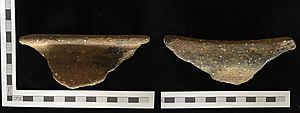Shelly-sandy ware facts for kids
Shelly-sandy ware (or SSW) is a special kind of pottery made a long time ago in Great Britain. It was made during the Middle Ages. This pottery is unique because it was mixed with both sand and shell. Most often, potters used quartz sand and crushed shells. The pottery usually looks dark grey inside. Its outer surfaces often have a brown color. Early SSW was made by hand. Later, potters started using a spinning wheel to shape it. This type of pottery was mainly made and sold between 1140 and 1220 AD. You could find it mostly around the Greater London area.
Contents
History of Shelly-Sandy Ware
Shelly-sandy ware was first made in the Greater London area. This happened between the years 1085 and 1108 AD. Before SSW, most pottery used only shell for strength. SSW was a step towards using only sand in pottery. It was made at the same time as other London pottery types. One example is London greyware (LOGR).
After 1140 AD, SSW became very popular. It was the most common pottery found in London. People continued to make it until about 1220 AD. We don't know exactly where SSW was first made. However, we know it was mostly used in London and nearby places.
What Shelly-Sandy Ware Looks Like
The Pottery Material (Fabrics)
Medieval pottery in Britain used different materials. Some had only shell, some had shell and sand, and some had sand with a little shell. Shelly-sandy ware includes both the shell-and-sand and the sand-with-shell types.
SSW made near London often used quartz sand. It also had crushed shells or whole shells mixed in. The pottery material is usually dark grey. Its outside surfaces are often brown. Most of the time, the shell type found in SSW is not easily identified. Oyster shell is also common. Sometimes, even snail shells have been found in pieces of pottery. The shells often look worn down. They can also be stained a light brown color.
Scientists have studied old pottery pieces. They found that the clay used for SSW had lots of plant matter. This included small pieces of wood, roots, leaves, and seeds. These plant bits were often mixed with tiny iron crystals. Small quartz grains, up to 0.5mm across, were also part of the material. The amount of sand and shell varied a lot in different pots. In some pieces, the sand grains are hard to see. In others, the quartz sand feels much rougher.
Shapes of Shelly-Sandy Ware
The shapes of SSW pottery were similar to older types. Jars and cooking pots were the most common items. Bowls and dishes were also made often. Sometimes, people made "curfews." These were like inverted bowls used to cover fires.
Bowls and dishes came in many sizes. They were deep and wide. These items usually had thin walls. Their rims looked similar to those on jars. Pitchers with spouts were also common. Most dishes were medium-sized, about 24 to 30 cm across. They usually had sides that flared out. Bowls and dishes with handles were very rare.
Decorations on Shelly-Sandy Ware
Potters used three main ways to decorate SSW. They would add strips, carve lines, or make impressions. You can often see faint horizontal lines on the pottery. These lines probably came from wiping the pot during finishing.
Adding clay strips was a common decoration. These strips were likely also used to make the pot stronger. They were usually placed up and down at even spaces. Wavy lines were also carved into the pottery. This was a quick and easy way to decorate. Wavy lines are mostly found on large bowls and dishes. They are less common on jars.
Most SSW items had only one type of decoration. If two types were used, thumb impressions were always one of them. Potters also often pressed their thumbs into the rims of larger bowls. This made the edges look nicer.
How Shelly-Sandy Ware Was Made
Shelly-sandy ware appeared when handmade pottery was slowly changing. More and more pottery was being shaped on a spinning wheel. SSW is special because it shows this change. Both handmade and wheel-thrown methods were used.
Studies of SSW pieces show how they were made. The bottom of the pot was usually shaped by hand. The main body of the pot was then built by hand or on a slow-turning table. The neck and rim were finished using a turning table or a fast-spinning wheel. None of the found examples show signs of being trimmed with a knife.
SSW usually has a light grey color inside. This color gets more reddish towards the surface. The outside surfaces are usually a dull, light brown. The inside and outside of the pottery usually have the same color. The pottery was heated at medium temperatures. This was probably between 700 and 800 degrees Celsius. The surface color likely came from removing some oxygen while the pottery cooled down. Shelly-sandy ware was not usually glazed. A few pieces of jars and dishes have been found with clear glaze splashes. However, these are quite rare.
See also
- Shelly ware
- Border ware
- Sandy ware
- List of English medieval pottery


